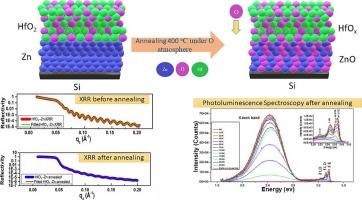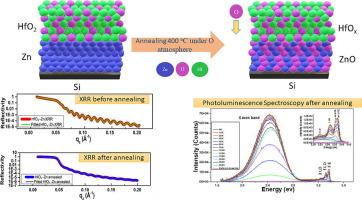Si/ZnO/HfO2埋地异质结构的内氧化制备与评价
IF 6.9
2区 材料科学
Q2 CHEMISTRY, PHYSICAL
引用次数: 0
摘要
金属氧化物在光电、压电、磁学等领域的应用处于最前沿。大带隙氧化物半导体异质界面生长可以通过控制化合物的II族元素的金属部分的转换来实现。本研究研究了在二氧化铪(HfO2)的作用下,通过埋藏金属锌层的内部氧化,在n型硅衬底上控制氧化锌(ZnO)薄膜的体外生长。在400 ℃的氧气气氛中控制退火,使厚度为44 nm的下层Zn层转变为厚度为37.5 nm的ZnO层。通过x射线衍射对长大后和退火后的Zn/HfO2层结构进行对比分析,清楚地表明Zn层完全转变为ZnO/HfOx异质界面,其中x <; 2。x射线反射率和x射线光电子能谱清楚地表明,HfO2层中的非化学计量表明O向其下的Zn层扩散并将其转化为ZnO。在x射线反射率中存在明确的条纹,清楚地表明高质量的异质界面,这使我们能够确定界面层厚度。在4 K下拍摄的低温光致发光光谱在3.37 eV附近清晰地显示出清晰的多阶近带边发射峰,该峰位于光谱的紫外区。这些发现强调了这种方法在开发不同应用的基于氧化物的埋藏低维异质结构方面的潜力。本文章由计算机程序翻译,如有差异,请以英文原文为准。


Fabrication and evaluation of a Si/ZnO/HfO2 buried heterostructure through internal oxidation
Metal-oxides are in the forefront of various applications in optoelectronic, piezo-electronics, magnetism etc. The large bandgap oxide semiconductor hetero-interface growth can be achieved through a controlled conversion of the metallic part of a group II elements of the compound. This study investigates the controlled in-vitro growth of zinc oxide (ZnO) thin films on n-type silicon substrates through the internal oxidation of a buried metallic Zn layer under hafnium dioxide (HfO2). Controlled annealing in an oxygen atmosphere at 400 °C resulted in the transformation of the underline Zn layer of thickness 44 nm into ZnO layer of thickness 37.5 nm. The comparative structural analysis of the as-grown and annealed Zn/HfO2 layers by x-ray diffraction clearly indicates complete conversion of the Zn layer to ZnO/HfOx hetero-interface, where x < 2. The x-ray reflectivity and x-ray photoelectron spectroscopy clearly indicates non-stoichiometry in the HfO2 layer indicating diffusion of O to the underlying Zn layer to convert it to ZnO. The presence of well-defined fringes in the x-ray reflectivity clearly suggest high quality hetero-interfaces which allows us to determine the interfacial layer thicknesses. Low temperature photoluminescence spectra taken at 4 K clearly showed sharp and well-defined multiple order near band edge emission peaks at around 3.37 eV, which falls in the UV region of the spectra. The findings underscore the potential of this method for developing oxide-based buried low-dimensional heterostructures for different applications.
求助全文
通过发布文献求助,成功后即可免费获取论文全文。
去求助
来源期刊

Applied Surface Science
工程技术-材料科学:膜
CiteScore
12.50
自引率
7.50%
发文量
3393
审稿时长
67 days
期刊介绍:
Applied Surface Science covers topics contributing to a better understanding of surfaces, interfaces, nanostructures and their applications. The journal is concerned with scientific research on the atomic and molecular level of material properties determined with specific surface analytical techniques and/or computational methods, as well as the processing of such structures.
 求助内容:
求助内容: 应助结果提醒方式:
应助结果提醒方式:


